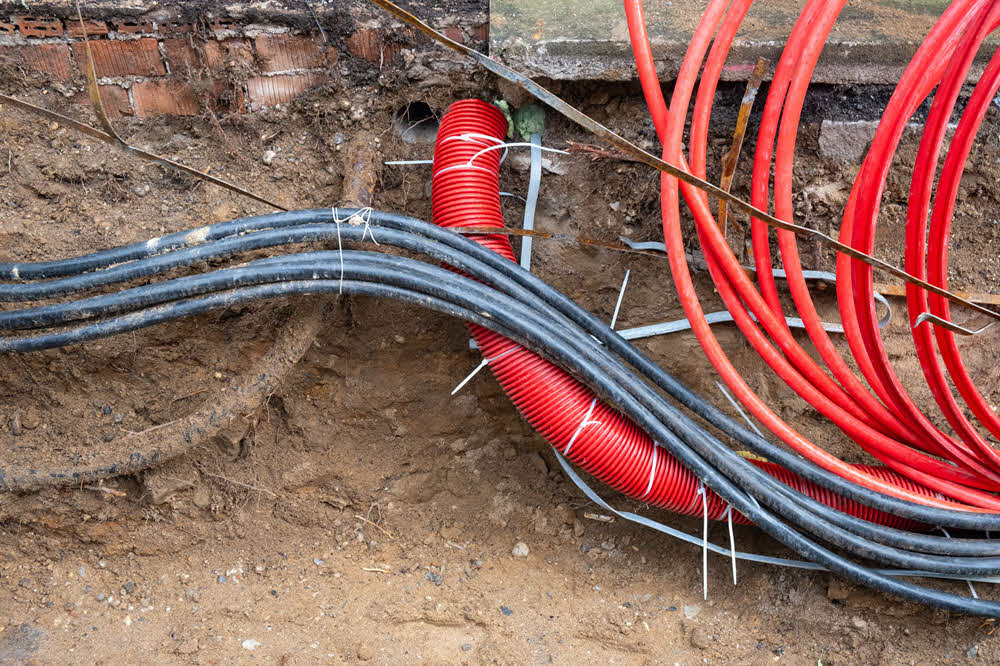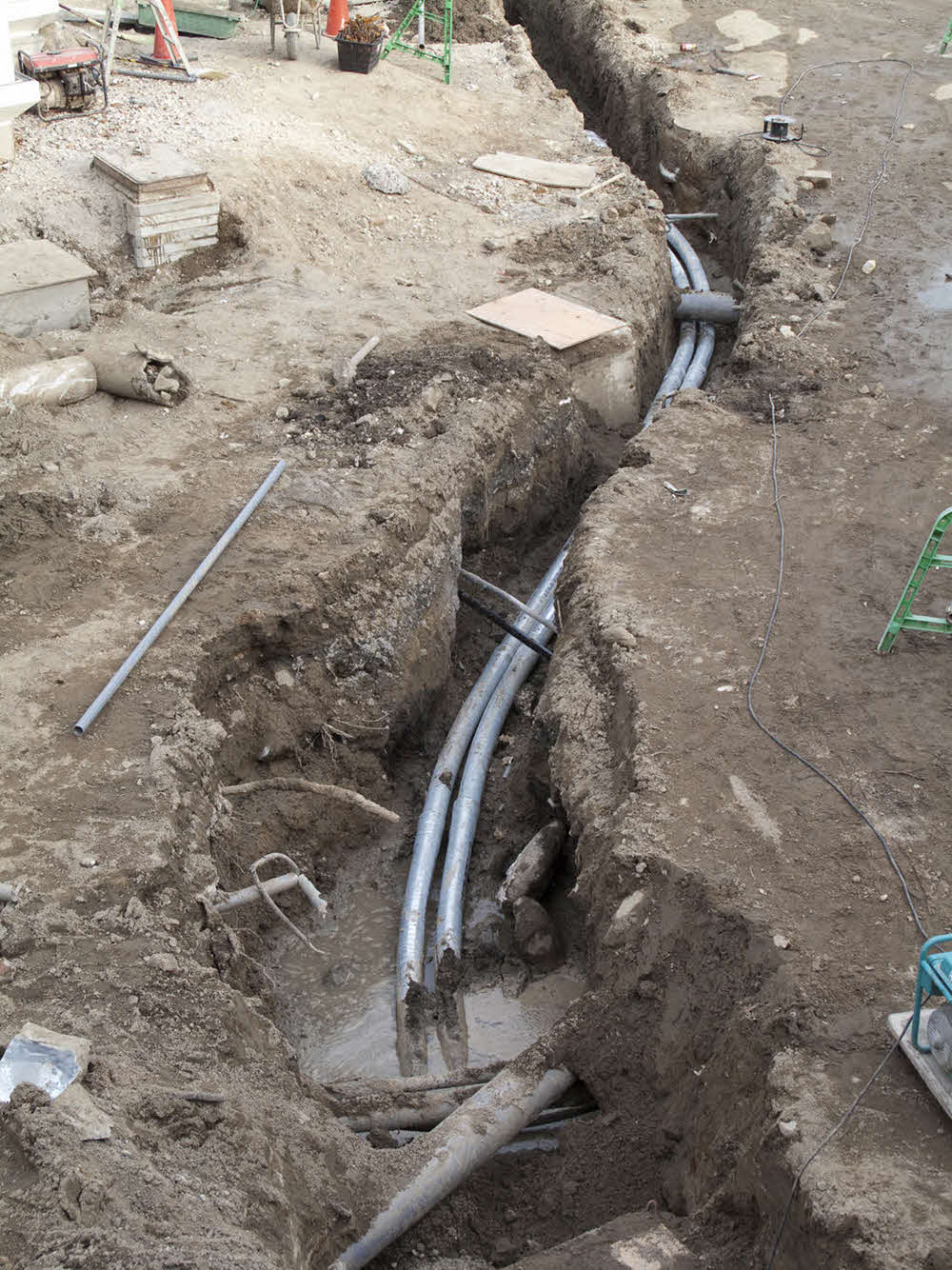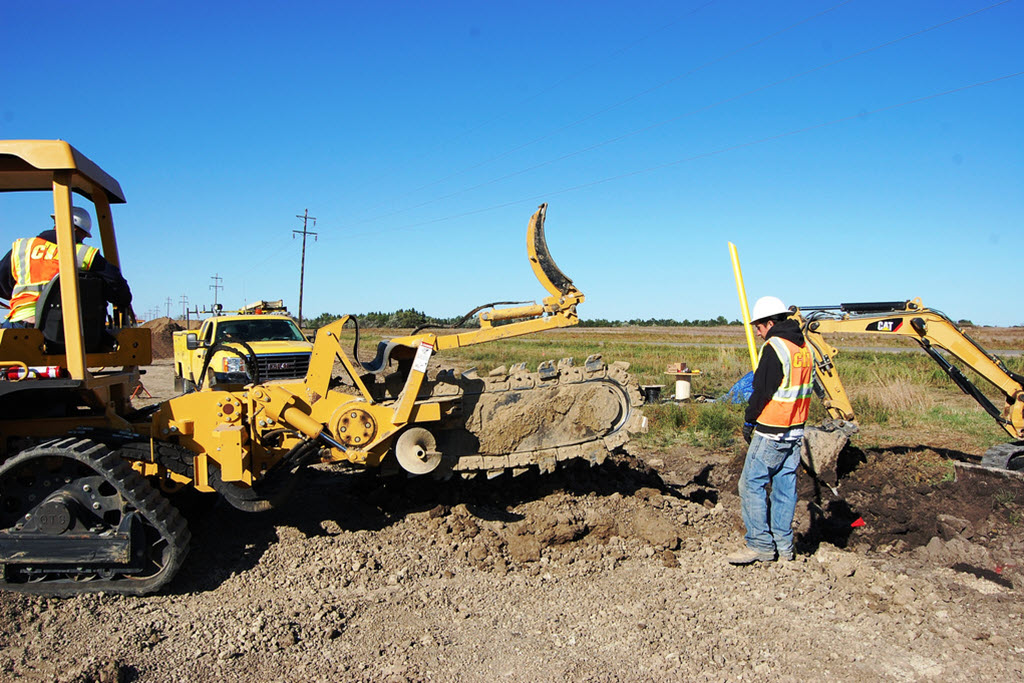Electrical Conduit Servicesin Saint Clair Shores MI
Expert Conduit Installation to Support Electrical and Data Systems
We Are Locally Owned & Operated For Over 37 Years
Contact Us Today!
We Serve Businesses In And Around The Following Cities:
About Electrical Conduit Services
Introduction: The Power beneath Saint Clair Shores
At the forefront of modern infrastructure in Saint Clair Shores lies an incredible technology. One that powers our businesses, drives our economy, and connects our lives seamlessly through an intricate network that remains largely unseen, helping to construct a city humming with energy. This is the power of a conduit for electrical underground, a critical component in ensuring reliable energy distribution for commercial properties.
The conduit underground electrical system has an extraordinary impact on the everyday running of businesses. It facilitates seamless operations by ensuring a steady supply of electricity, protected from the capricious elements of weather, accidental disruptions, or even intentional tampering. It’s a silent marvel that stays hidden, operating efficiency and reliability, yet reflecting in everything from the operational continuity of businesses to the city’s overall economic prosperity.
Understanding the Conduit for Electrical Underground
A conduit underground electrical system is fundamentally a pathway for electrical wiring to travel safely under the ground. It is often constructed with rigid materials like PVC, designed for durability under a variety of environmental conditions. Underground electrical conduit is a far safer option than overhead electrical wires and significantly reduces the hazards associated with fallen power lines or damaged infrastructure.
Underground conduit installation is a meticulous process, involving trenching for electrical conduit, routing the conduit and wires, and finally backfilling the trench. It involves careful coordination of skilled craftsmanship, quality materials, and technology to achieve a flawless installation that promises long-term reliability. Installing PVC conduit underground offers certain advantages such as corrosion resistance, light-weight design, and affordability, making it a preferred choice for many businesses.
The Process: Outlining the Steps for Successful Installation
Installing a conduit for an underground electrical system is a strategic process that demands precision and expertise. Beginning with a clear understanding of property layout and existing utilities, an experienced team outlines the best trench electrical line route, ensuring minimal disruption and maximum efficiency.
Running an underground electrical line starts with trenching for electrical conduit. Professionals use specialized machinery for this task, maintaining a specified depth to ensure safety standards are met. The trench is prepared to protect the conduit from extreme weather and possible external damages. Installing PVC conduit for underground wiring comes next, a painstaking process that involves feeding the wires through the conduit before sealing it.
Running electrical wire near a gas line is approached with utmost care. Skilled experts ensure that there’s an adequate buffer distance between the two to prevent any safety hazards. Finally, the process concludes with the installation of the service panel and backfilling the trench. It’s a process that, when executed efficiently, provides secure, reliable power for every commercial property involved.
Transforming Businesses in Saint Clair Shores
Through conduit installation for underground electrical systems, a myriad of businesses in Saint Clair Shores have experienced remarkable enhancements in their daily operations. From warehouses and restaurants to office buildings and retail outlets, running an underground power line has proven to be a pillar of efficiency and reliability.
In the local automotive part manufacturing industry, for instance, uninterrupted operations are crucial. Even a minor breakdown of power can lead to significant operational disruptions and financial losses. Strategic installation of underground conduit systems by companies like D&J Contracting has brought a new sense of consistency and certainty to such businesses, providing an electrical system that is safe, secure, and highly reliable.
Trust D&J Contracting: Your Conduit for Success
The installation of a conduit for underground electrical systems requires specialist knowledge and experience. D&J Contracting offers precisely this expertise, providing comprehensive solutions from underground conduit installation to running underground electrical service. The skilled team at D&J Contracting understands the importance of maintaining safety while running wire in conduit underground, thereby assuring the highest quality of service at every step.
From trenching for underground electric to backfilling the trench, D&J Contracting uses top-quality materials and state-of-the-art equipment to ensure efficiency and reliability. As a result, businesses throughout Saint Clair Shores have benefited from the steadfast expertise of D&J Contracting, appreciating the firm’s commitment to excellence and attention to detail.
A Brighter Tomorrow
As businesses in Saint Clair Shores continue to thrive, having a secure and efficient electrical system remains a significant factor in their success. Deploying a conduit for electrical underground is no longer just a choice but an operational necessity. A guarantee of secure, reliable, and seamless energy, it is a testament to the city’s commitment to offering its businesses the best possible environment to flourish.
In this light, D&J Contracting stands as a trusted partner for businesses across Saint Clair Shores, delivering quality and reliability through its professional services. If you’re looking to establish or upgrade your commercial property’s electrical system, bringing experts from D&J Contracting onboard will illuminate your path to success.
Electrical Conduit Services Gallery


Call Us Today to receive your Free Quote for
Conduit For Electrical Underground in Saint Clair Shores
Serving: Saint Clair Shores, Michigan

About Saint Clair Shores, Michigan
|
|
This section does not cite any sources. (February 2019)
|
Located along the shores of Lake St. Clair and inhabited by French settlers as early as 1710, during which time the area was referred to as L’anse Creuse, the future St. Clair Shores would remain mainly a rural farming area populated by largely French and German immigrant families into the early 20th century. These local family surnames have survived into the 21st century and can be found in the surnames of current residents and among numerous residential street names.
From 1835 until 1843, the area was part of Orange Township, among the first townships platted in Michigan and part of Macomb County. In 1843, Orange Township was renamed Erin Township, in homage to the numerous Irish immigrants who had moved into the area and had begun to exert their political influence. From 1843 until 1911, what is now St. Clair Shores was a part of Erin Township, parts of which make up today’s municipalities of Eastpointe, Roseville, and St. Clair Shores.
In 1911, the eastern portion of Erin Township was partitioned off to become Lake Township. St. Clair Shores was incorporated as a village in 1925 and remained a part of Lake Township until, after numerous failed attempts, its residents voted to incorporate as the city of St. Clair Shores in January 1951. Lake Township continued adjacent to the city until 2009, when residents of the village of Grosse Pointe Shores (that portion of Grosse Pointe Shores in Macomb County located within Lake Township) voted to incorporate as a city.
Beginning around the time of the First World War, St. Clair Shores became a favored playground for gamblers, rum runners, and lakefront tourists alike, culminating during Prohibition, but continuing through the Second World War era. During these years, the village was the home to many popular roadhouses, blind pigs, and gambling establishments, such as the Blossom Heath Inn. St. Clair Shores’ lakefront location and proximity to Canada coupled with a receptive and often participative community made it an advantageous haven for rum runners, and the area was actively involved in the rum-running era of Prohibition. Local residents, politicians, and law enforcement of the era were known to sometimes conflict with both state and federal officials over their attempts to regulate these illegal, but economically vital, activities within the community.
The Eagle Pointe subdivision, one of many platted within the village of St. Clair Shores during the early 20th century, was platted along a part of the lake shore in 1916. During the next few decades, dozens of subdivisions were platted through the local farmland, but most were not developed in earnest until after the Second World War, when St. Clair Shores became the fastest-growing suburb of Detroit during the 1950s.
From 1927 until 1959, the community was the location of the Jefferson Beach Amusement Park, a major lakefront attraction for the Detroit area and beyond. Opened in 1927, it boasted the longest roller coaster in the United States and numerous other midway attractions, a large, ornate lakefront dance pavilion, and a large, sandy beach popular with swimmers and sun bathers. In 1955, a fire destroyed some of the attractions and buildings within the once-popular park, and this, coupled with changing public tastes, accelerated its demise. While the owners of Jefferson Beach Amusement Park considered rebuilding, by this time the park was not popular with local government officials, and the city council had begun exploring forcing the closure of the facility or purchasing it for public use. Instead, the park owners, who had previously started building an onsite marina facility, began to expand that part of the facility. By 1959, the remaining park amusements and buildings were demolished to make room for the greatly enlarged Jefferson Beach Marina. All that remained of the once grand amusement park was its large, ornate lakefront dance coliseum, which for years thereafter was relegated to use as a marina storage facility and marine supply store until it, too, was destroyed by fire.
St. Clair Shores is in southern Macomb County, on the western side of Lake St. Clair. It is bordered to the west by the cities of Roseville and Eastpointe and to the south, in Wayne County, by Harper Woods, Grosse Pointe Woods, and Grosse Pointe Shores. Interstate 94 runs along the western edge of the city, with access from Exits 224 through 230. I-94 leads southwest 13 miles (21 km) to midtown Detroit and northeast 40 miles (64 km) to Port Huron.
According to the U.S. Census Bureau, St. Clair Shores has a total area of 14.40 square miles (37.30 km), of which 2.72 square miles (7.04 km), or 18.9%, are covered by water. The city has 14 miles (23 km) of canals. Most of these canals are found in the Nautical Mile, which is along Jefferson between 9 Mile and 10 Mile Roads.
| Census | Pop. | Note | %± |
|---|---|---|---|
| 1930 | 6,745 | — | |
| 1940 | 10,405 | 54.3% | |
| 1950 | 19,823 | 90.5% | |
| 1960 | 76,657 | 286.7% | |
| 1970 | 88,093 | 14.9% | |
| 1980 | 76,210 | −13.5% | |
| 1990 | 68,107 | −10.6% | |
| 2000 | 63,096 | −7.4% | |
| 2010 | 59,715 | −5.4% | |
| 2020 | 58,874 | −1.4% | |
| U.S. Decennial Census 2018 Estimate |
|||
As of the census of 2010, there were 59,715 people, 26,585 households, and 15,932 families living in the city. The population density was 5,139.0 inhabitants per square mile (1,984.2/km). There were 28,467 housing units at an average density of 2,449.8 per square mile (945.9/km). The racial makeup of the city was 92.7% White, 3.9% African American, 0.3% Native American, 1.0% Asian, 0.2% from other races, and 1.7% from two or more races. Hispanic or Latino residents of any race were 1.7% of the population.
Of the 26,585 households, 24.6% had children under 18 living with them, 43.6% were married couples living together, 11.9% had a female householder with no husband present, 4.4% had a male householder with no wife present, and 40.1% were not families. About 35.1% of all households were made up of individuals, and 15.5% had someone living alone who was 65 or older. The average household size was 2.24, and the average family size was 2.90.
The median age in the city was 44.2 years; 19% of residents were under 18; 7% were between18 and 24; 24.9% were from 25 to 44; 29.7% were from 45 to 64; and 19.2% were 65 or older. The gender makeup of the city was 47.8% male and 52.2% female.
As of the census of 2000, 63,096 people, 27,434 households, and 17,283 families were living in the city. The population density was 5,472.3 inhabitants per square mile (2,112.9/km). The 28,208 housing units had an average density of 2,446.5 per square mile (944.6/km). The racial makeup of the city was 96.89% White, 0.69% African American, 0.28% Native American, 0.84% Asian, 0.20% from other races, and 1.10% from two or more races. Hispanic or Latino residents of any race were 1.18% of the population.
Of the 27,434 households, 24.1% had children under 18 living with them, 49.5% were married couples living together, 10.0% had a female householder with no husband present, and 37.0% were not families. About 32.7% of all households were made up of individuals, and 16.3% had someone living alone who was 65 years of age or older. The average household size was 2.28 and the average family size was 2.92.
In the city, the age distribution was 20.2% under 18, 6.2% from 18 to 24, 28.8% from 25 to 44, 23.1% from 45 to 64, and 21.8% who were 65 or older. The median age was 42 years. For every 100 females, there were 90.9 males. For every 100 females 18 and over, there were 86.8 males.
The median income for a household in the city was $49,047, and for a family was $59,245. Males had a median income of $46,614 versus $31,192 for females. The per capita income for the city was $25,009. About 2.6% of families and 3.7% of the population were below the poverty line, including 4.4% of those under 18 and 4.9% of those 65 or over.
St. Clair Shores has three school districts: South Lake Schools, which serves the southern portion of the city, Lakeview Public Schools, which serves the central portion of the city, and Lake Shore Public Schools, which serves the northern portion of the city. Each district operates one high school within the city.
Private, parochial schools include St. Germaine, St. Isaac Jogues, and St. Joan of Arc.
Call Us Today to receive your Free Quote for
Conduit For Electrical Underground in Saint Clair Shores
Related Services in Saint Clair Shores, Michigan
We Serve Businesses In The Following Zip Codes:
48007, 48015, 48021, 48026, 48035, 48036, 48038, 48042, 48043, 48044, 48045, 48046, 48047, 48048, 48050, 48051, 48066, 48071, 48080, 48081, 48082, 48083, 48084, 48085, 48088, 48089, 48090, 48091, 48092, 48093, 48098, 48099, 48225, 48230, 48236, 48310, 48311, 48312, 48313, 48314, 48315, 48316, 48317, 48318, 48397